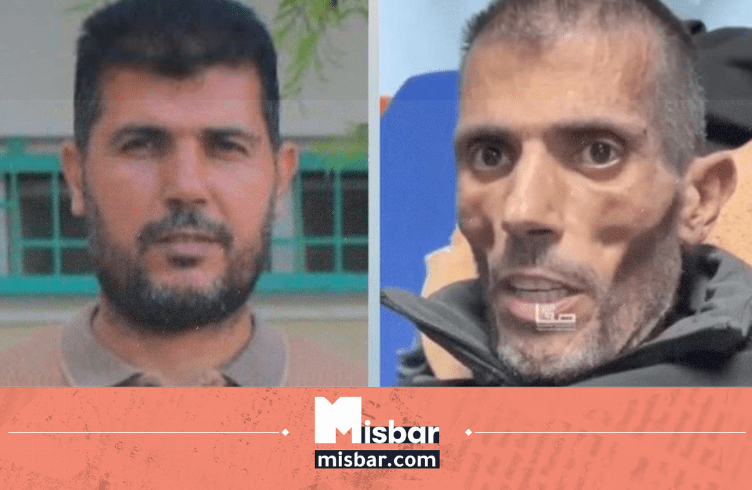The Case of Ibrahim al-Shaweesh: Unmasking Israeli Disinformation on Palestinian Prisoner Treatment
The release of Palestinian prisoner Ibrahim Mohammad Khaleel al-Shaweesh from Israeli detention sparked a wave of online disinformation aimed at discrediting his account of torture and mistreatment. Al-Shaweesh, a teacher from Beit Hanoun in Gaza, was arrested on December 10, 2023, and held until February 8, 2025. Following his release, videos circulating on social media depicted the alarming physical condition of the former detainee, bearing apparent signs of abuse. In response to the growing public outcry, pro-Israel accounts initiated a coordinated campaign to deny al-Shaweesh’s imprisonment and downplay the severity of conditions within Israeli prisons.
Central to this disinformation effort was the dissemination of a list purporting to contain the names of all 736 Palestinian prisoners released in the first phase of a prisoner exchange. This list, circulated by Israeli trolls, conspicuously omitted al-Shaweesh’s name, leading some to question the veracity of his claims. Furthermore, other false narratives emerged, including allegations that al-Shaweesh had been hospitalized for stomach cancer and received treatment, not torture, in Israel. These claims were strategically amplified through various social media platforms, including X (formerly Twitter), where some users exploited the Community Notes feature to further disseminate the misleading information by linking to the incomplete Israeli government prisoner list.
Misbar’s investigative team debunked these claims by meticulously examining the Israeli government’s official list. The investigation revealed a critical flaw: the list only included prisoners from the West Bank and other occupied territories outside of Gaza and excluded thousands of Gazan detainees imprisoned after October 7, 2023—a group to which al-Shaweesh belonged. These Gazan prisoners, arrested as part of the ongoing conflict, were being released in phases separate from the initial 736 listed individuals. This crucial detail, deliberately omitted by the pro-Israel accounts, exposed their efforts to manipulate public perception and shield Israel from accountability for the alleged mistreatment of Palestinian prisoners.
Further corroborating al-Shaweesh’s account, Misbar cross-referenced his name against independent lists compiled by Palestinian prisoner advocacy organizations. Both the Asra Media Office and the Palestinian Commission of Detainees and Ex-Detainees (CDA) included al-Shaweesh’s name among the 111 Gazan detainees released on February 8, 2025. These independent verifications, coupled with the flawed Israeli government list, solidify the evidence of al-Shaweesh’s imprisonment and expose the deceptive nature of the online disinformation campaign. The convergence of these independent sources provides irrefutable proof of al-Shaweesh’s detention, undermining the Israeli propaganda attempting to rewrite the narrative.
In his first interview after release, al-Shaweesh detailed the harrowing treatment he endured in Israeli custody. He described being blindfolded and shackled for 45 days, subjected to sleep deprivation, and later transferred to the Negev prison, where he was allegedly subjected to electric shocks and attacks by dogs. This testimony aligns with reports from numerous other Palestinian prisoners who have described similar forms of abuse within the Israeli prison system, painting a grim picture of systematic mistreatment and torture. These accounts of abuse challenge the narrative promoted by Israeli trolls and underscore the urgency for an independent investigation into conditions within these facilities.
The case of Ibrahim al-Shaweesh underscores the complex information landscape surrounding the Israeli-Palestinian conflict. The deliberate spread of misinformation, amplified by social media algorithms and exploited by politically motivated actors, poses a significant challenge to establishing truth and accountability. The incident also highlights the importance of relying on verifiable sources and engaging in critical analysis of information, especially in highly contested and emotionally charged contexts. The attempt to discredit al-Shaweesh’s experience reflects a broader pattern of silencing Palestinian voices and deflecting scrutiny from allegations of human rights abuses.
The ongoing prisoner exchange, part of a ceasefire agreement in Gaza, has been marked by controversy and delays. While the Palestinian Resistance released three Israeli captives, Israel released 183 Palestinian detainees, including al-Shaweesh. Reports indicate that many freed Palestinian prisoners require urgent medical attention due to the alleged harsh conditions of their imprisonment. The planned release of additional prisoners, including 1,000 minors arrested in Gaza, has been reportedly postponed by the Palestinian Resistance due to alleged Israeli violations of the ceasefire agreement. The fragility of the ceasefire and the ongoing disputes over its implementation highlight the deep-seated mistrust between the two sides and the challenges in achieving a lasting peace. The use of disinformation campaigns further complicates these efforts and fuels the cycle of mistrust and hostility.


